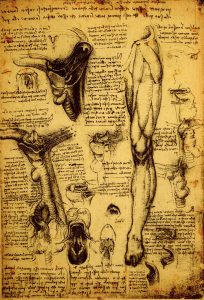Veni, Vidi, Da Vinci
What made Leonardo da Vinci a genius? I’ve just finished Walter Isaacson’s all-purpose biography of the Italian Renaissance man and four words come to mind: curiosity, observation, analogy, and humility. These four traits combined and recombined throughout Leonardo’s life to create advances in painting, engineering, architecture, anatomy, hydrology, optics, weaponry, and theater.
Leonardo maintained a childlike curiosity throughout his life. Every kid wants to know why the sky is blue. As we reach adulthood, most of us simply accept the fact that the sky is indeed blue. Not Leonardo. He studied the question for much of his adult life and ultimately developed an explanation based on clear evidence and careful reasoning.
Leonardo combined his curiosity with powers of observation that beggar belief. He noticed, for instance, that dragonflies have four wings, two forward and two aft. He wondered how they worked. By close observation, he concluded that when the two forward wings go up, the two aft wings go down. It seems like a simple observation but it must have taken hours of acute and disciplined observation.
Similarly, he took an interest in how birds flap their wings. Do their wings move faster as they flap upward or downward? Most of us would not conceive of such a question, much less focus our attention sufficiently to answer it. But Leonardo did, not once but several times.
His first observations – taken over many hours and days – suggested that birds flap their wings faster on the down stroke. At this point, I would have recorded my observation, concluded that all birds behaved similarly, and moved on. But Leonardo persisted. He observed different bird species and found that some flap faster on the up stroke than the down stroke. Wing behavior differs by species. It’s an interesting observation about birds. It’s a fascinating observation about Leonardo. Arthur Bloch once said that, “A conclusion is the place where you get tired of thinking.” Leonardo, apparently, never got tired of thinking. He recognized that all conclusions are tentative.
Leonardo didn’t just study insects and birds. He studied pretty much everything – from rivers to trees to pumps to blood circulation to optical effects to anatomy to geometry to Latin to … well, whatever caught his eye. His breadth of knowledge allowed him to draw analogies that others would have missed. Some of his analogies seem “obvious” to us today – like the analogy between water flow in rivers and blood flow in humans.
But how about the analogy between arteriosclerosis and oranges? As he dissected cadavers, Leonardo noticed that older people’s arteries were often less flexible and more clogged that those of younger people. He became the first person in history to accurately describe arteriosclerosis. He did so by comparing it to the rind of an orange that dries, stiffens, and thickens as it ages.
In today’s world, expertise is often associated with narrowness. Experts gain ever more knowledge about ever-narrower subjects. Leonardo was certainly an expert in several narrow domains. But he also saw across domains and could think outside the frame. Philip Tetlock, an authority on political judgment, suggests that this ability to think across boundaries is a key ingredient to insight and discovery. In many ways, Leonardo thought more like a fox and less like a hedgehog.
If I could think and observe like Leonardo, I might become a bit of a prima donna. But Leonardo never did. He remained humble and diffident in an ever-changing world. As Isaacson notes, he “… relished a world in flux.” Further, “When he came up with an idea, he devised an experiment to test it. And when his experience showed that a theory was flawed … he abandoned his theory and sought a new one.” By revising and updating his own conclusions, Leonardo helped establish a world in which observation and experience trump dogma and received wisdom.
Leonardo’s legacy is so broad and so varied that it’s difficult to encapsulate succinctly. But Isaacson includes a quote the German philosopher, Schopenhauer, that helps us understand his impact: “Talent hits a target that no one else can hit. Genius hits a target that no one else can see.”
